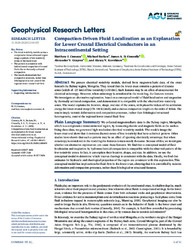Compaction-Driven Fluid Localization as an Explanation for Lower Crustal Electrical Conductors in an Intracontinental Setting
DOI: https://doi.org/10.1029/2020GL088455
Persistent URL: http://resolver.sub.uni-goettingen.de/purl?gldocs-11858/9422
Persistent URL: http://resolver.sub.uni-goettingen.de/purl?gldocs-11858/9422
Comeau, Matthew J.; Becken, Michael; Connolly, James A. D.; Grayver, Alexander V.; Kuvshinov, Alexey V., 2020: Compaction-Driven Fluid Localization as an Explanation for Lower Crustal Electrical Conductors in an Intracontinental Setting. In: Geophysical Research Letters, Band 47, 19, DOI: 10.1029/2020GL088455.
 |
View/
|
We present electrical resistivity models, derived from magnetotelluric data, of the crust beneath the Bulnay region, Mongolia. They reveal that the lower crust contains a pattern of discrete zones (width of ~25 km) of low resistivity (<30 Ωm). Such features may be an effect of unaccounted-for electrical anisotropy. However, when anisotropy is considered in the modeling, the features remain. We investigate an alternative explanation, based on a conceptual model of fluid localization and stagnation by thermally activated compaction, and demonstrate it is compatible with the observed low-resistivity zones. The model explains the location, shape, and size of the zones, with plausible values of the activation energy for lower crustal creep (270–360 kJ/mol), and a viscous compaction length on the order of 10 km. The results imply tectonic deformation and compaction processes, rather than lithological-structural heterogeneity, control the regional lower crustal fluid flow.
Statistik:
View StatisticsCollection
This is an open access article under the terms of the Creative Commons Attribution-NonCommercial License, which permits use, distribution and reproduction in any medium, provided the original work is properly cited and is not used for commercial purposes.

